Christmas occupies a central place in the Christian religion, marking the celebration of the birth of Jesus Christ, a central figure of Christianity. This holiday, traditionally celebrated on December 25 by Christians around the world (January 7 for the Orthodox), symbolizes the incarnation of God in Jesus Christ, his coming to Earth among men. The nativity, the central scene of the celebrations, evokes the simplicity and humility of the birth of Jesus in a stable, emphasizing God's choice to incarnate in modesty rather than earthly grandeur.
From the first centuries of Christianity, the nativity of Jesus became a central subject in religious art. Representations of the Virgin Mary holding the Baby Jesus, surrounded by Joseph, shepherds, and sometimes the wise men, have become iconic. Renaissance artists like Giotto, Fra Angelico, and later, Caravaggio, brought an emotional depth and realism to these scenes that marked a turning point in the artistic approach to the nativity.
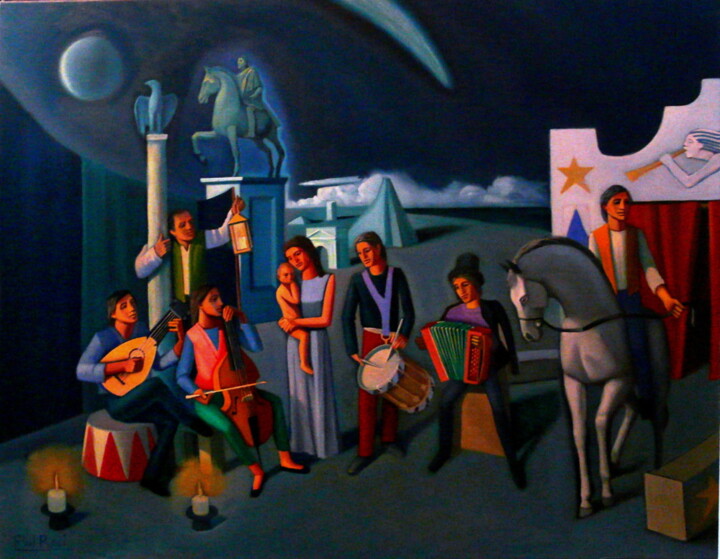 Nativity Parody, Painting on Canvas, 71x91 cm, Paul Rossi
Nativity Parody, Painting on Canvas, 71x91 cm, Paul Rossi
History and Origins
The origins of religious Christmas art, particularly early depictions of the nativity, date back to the early centuries of Christianity. This art evolved in parallel with the spread and acceptance of Christianity in the Roman world and beyond, reflecting the beliefs, traditions, and religious practices of the time.
First Performances
The very first depictions of the nativity are not documented until the 2nd century. Early Christians, often operating in secret due to persecution, used Christian symbols such as the fish (ichtus) to recognize each other. It was only after Christianity was legalized by the Edict of Milan in 313 AD, under Emperor Constantine, that Christian art began to flourish publicly.
Catacombs and First Symbols
The Roman catacombs offer some of the earliest examples of Christian art, with wall frescoes depicting biblical scenes, perhaps including allusions to the nativity. However, these representations were symbolic and not literal, often centering on the theme of salvation and resurrection.
Evolution of the Representation of the Nativity
The nativity, as we know it today with Mary, Joseph, the baby Jesus in a manger, the shepherds and the wise men, began to take shape in Byzantine art around the 6th century. These early depictions were highly stylized and symbolic, often incorporating elements of ancient Christian iconography.
Byzantine Influence and Later Development
Byzantine art played a crucial role in spreading depictions of the nativity across Christian Europe. Icons, with their distinctive style and use of gold to symbolize the divine, presented the nativity as a sacred event, shrouded in mystery and veneration.
In the Middle Ages, religious Christmas art began to diversify. Frescoes, illuminated manuscripts, and stained glass windows began to depict the nativity with greater detail and narrative elements, often influenced by the accounts of the apocryphal Gospels.
The Nativity scene of Saint Francis of Assisi
An important step in the evolution of religious Christmas art was the introduction of the nativity scene by Saint Francis of Assisi in 1223. Recreating the nativity scene with real people and animals in Greccio, Italy, Francis sought to make the story of Jesus' birth more accessible and understandable to the people. This event marked the beginning of the Nativity scene tradition, which would become a central part of Christian art and devotion during the Christmas season.
Renaissance and Later Periods
During the Renaissance, religious Christmas art reached new heights with artists like Giotto, Leonardo da Vinci, and Sandro Botticelli, who brought an emotional depth and realism to the nativity never before seen. Their works, characterized by careful attention to human detail and divine light, not only conveyed the spiritual meaning of the nativity but also reflected the evolving artistic knowledge and techniques of their times.
The Main Themes of Religious Christmas Art
Common Elements of the Nativity
Although depictions of the nativity vary, certain elements remain almost universally present:
- Mary and the Baby Jesus: At the center of almost all nativity scenes, Mary is often depicted in adoration or contemplation before the Baby Jesus, usually lying in a manger.
- Joseph: Usually present alongside Mary, Joseph is often depicted in a supporting role, sometimes in contemplation or in action.
- The Shepherds: Inspired by the announcement made to the shepherds by the angels, these characters symbolize the revelation of the birth of Jesus to the humble.
- The Magi: Coming from the East, guided by a star, they represent the recognition of Jesus by the non-Jewish world and bring gifts of great symbolic value: gold, incense and myrrh.
- The Angel: Often present announcing the good news, the angel is a heavenly messenger who plays a key role in the story.
- The Star of Bethlehem: Guiding the wise men to Jesus, the star is an important symbol of divine guidance and revelation.
Cultural and Historical Variations
- Byzantine and Medieval: The first representations are strongly symbolic, with stylized characters and simplified decorations, often golden, emphasizing the sacred nature of the event.
- Renaissance: The introduction of more realistic perspectives, the use of natural landscapes and human emotional expressions deepens the narrative dimension of the nativity. Artists like Giotto and Botticelli incorporate details of everyday life, making the scene more accessible.
- Baroque: Characterized by increased drama, play of light and shadow, and more intense character dynamics. Caravaggio, for example, uses light to focus attention on the Child Jesus.
- Modern and Contemporary: Interpretations can vary widely, from following conventions to abstract or symbolic representations, reflecting a wide range of artistic styles and perspectives.
Mediums and Techniques
Paint
Important artists and paintings celebrating Christmas and the Nativity.
Giotto di Bondone (1267-1337)
The Nativity of the Scrovegni Chapel: This fresco by Giotto, located in Padua, is famous for its humanized representation of the nativity scene, highlighting deeply human emotions and an innovative realism for the time. Nativity, Giotto (1306) - 200x185 cm
Nativity, Giotto (1306) - 200x185 cm
Sandro Botticelli (1445-1510)
The Mystical Nativity: Botticelli combines religious and mythological elements in this work, offering a complex and rich vision of the nativity, with symbolic details that invite reflection.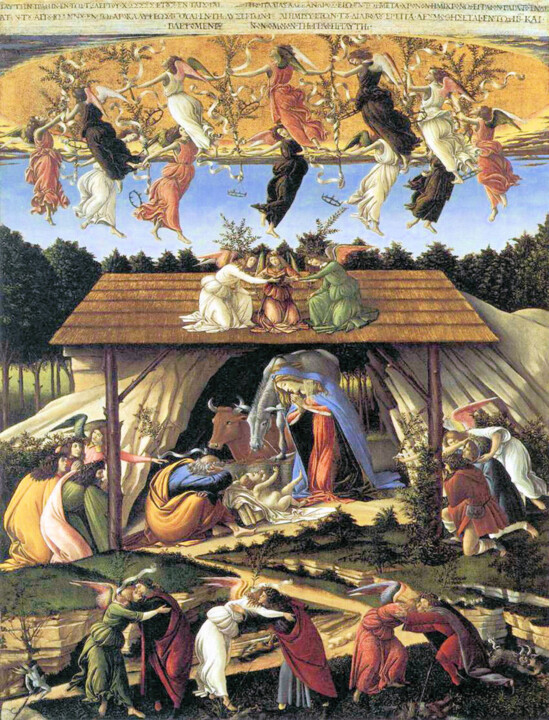 The Mystical Nativity, Botticelli (1501) - 108.5x75 cm
The Mystical Nativity, Botticelli (1501) - 108.5x75 cm
Albrecht Dürer (1471-1528)
The Nativity: Dürer brought remarkable precision and attention to detail to Northern Renaissance art, his engravings of the nativity being particularly appreciated for their finesse and expressiveness.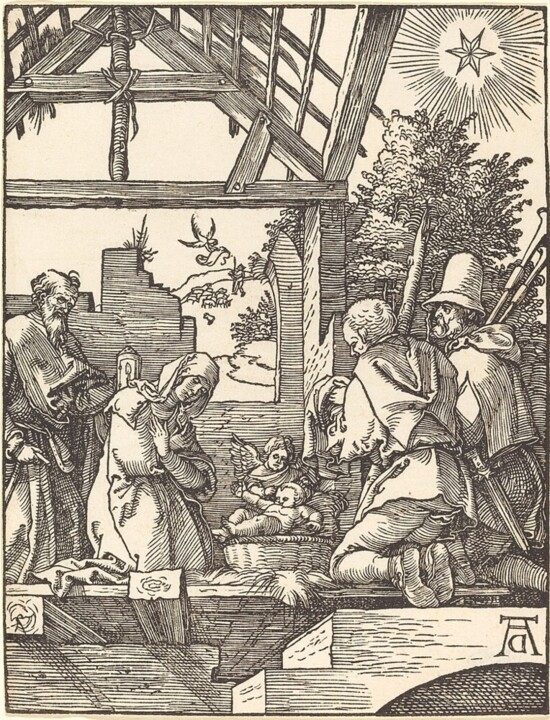 The Nativity, Albrecht Dürer, (1511) - 12.8x9.8 cm
The Nativity, Albrecht Dürer, (1511) - 12.8x9.8 cm
Caravaggio (Michelangelo Merisi) (1571-1610)
Adoration of the Shepherds: Caravaggio is famous for his dramatic use of chiaroscuro and raw realism. His “Adoration of the Shepherds” presents a moving and intimate nativity scene, with expressive figures bathed in divine light. The Adoration of the Shepherds, Caravaggio (1609) - 314x211 cm
The Adoration of the Shepherds, Caravaggio (1609) - 314x211 cm
Georges de La Tour (1593-1652)
The Worship of the Shepherds: The Tower is known for its ability to use light to create an intimate and meditative atmosphere. His rendition of the Adoration of the Shepherds is a striking example of this technique, with light coming from the Child Jesus illuminating the faces of the surrounding figures. The Adoration of the Shepherds, Georges de La Tour (1645) - 107x131 cm
The Adoration of the Shepherds, Georges de La Tour (1645) - 107x131 cm
Peter Paul Rubens (1577-1640)
The Adoration of the Magi: Rubens, with his dynamic and colorful style, produced several works depicting the nativity and the adoration of the Magi, characterized by their energy, movement and richness of detail.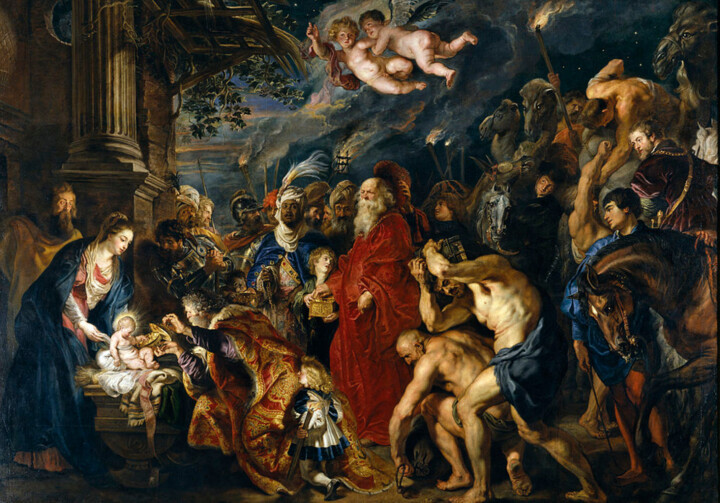 The Adoration of the Magi, Peter Paul Rubens (1609) - 355 × 493 cm
The Adoration of the Magi, Peter Paul Rubens (1609) - 355 × 493 cm
Sculpture
Nativity bas-reliefs and sculptures were created by many artists. Here are some notable examples that illustrate the richness and diversity of these art forms:
Arnolfo di Cambio (c. 1240-1310): Considered one of the precursors of Italian Renaissance sculpture, di Cambio created one of the first known carved nativity scenes, for the Church of Santa Maria Maggiore in Rome. This work marks an important moment in the history of nativity art. Nativity set, Basilica of Santa Maria Maggiore (Rome), credit: Stefano Bolognini via Wikipedia
Nativity set, Basilica of Santa Maria Maggiore (Rome), credit: Stefano Bolognini via Wikipedia
Gian Lorenzo Bernini (1598-1680): Although Bernini is best known for his dynamic Baroque sculptures, his religious works, such as the Ecstasy of Saint Teresa, show his ability to infuse his sculptures with spirituality and emotion, elements which would have influenced representations of the nativity in Baroque art.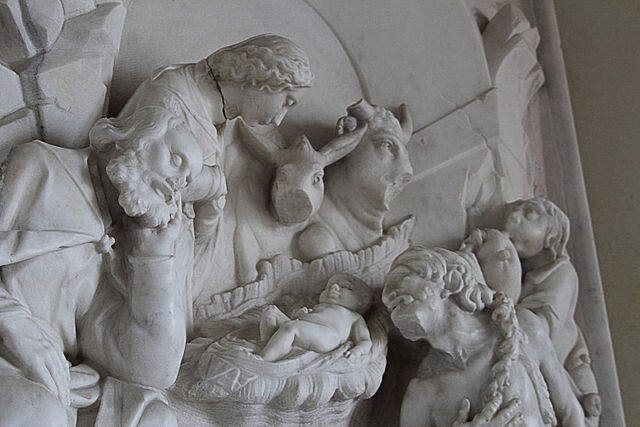 Nativity, Gian Lorenzo Bernini (Convent of San Bernardino da Siena) credit: SettimioMa via Wikipedia
Nativity, Gian Lorenzo Bernini (Convent of San Bernardino da Siena) credit: SettimioMa via Wikipedia
Antonio Begarelli (1499-1565): Begarelli, active in Modena, Italy, was known for his groups of clay figures depicting scenes from the life of Christ, including the nativity. His works, notable for their expression and naturalism, influenced Italian Renaissance sculpture.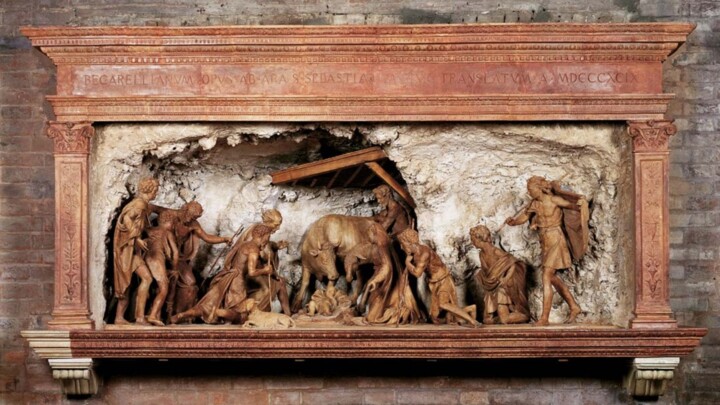 Nativity, Antonio Begarelli, Modena Cathedral (Italy)
Nativity, Antonio Begarelli, Modena Cathedral (Italy)
Crafts and Decorations
Christmas crafts and decorations, particularly nativity scenes, stained glass windows, and other forms of artistic expression, are essential parts of the celebration of the nativity in many cultures.
Nurseries
- Saint Francis of Assisi : Although not an "artist" in the traditional sense, Saint Francis of Assisi is credited with creating the first living nativity scene in 1223 in Greccio, Italy, a tradition that inspired the creation of sculpted and modeled nativity scenes throughout the Christian world.
- Arnolfo di Cambio : Famous for designing the first known carved nativity scene around 1291, his figures are among the earliest examples of three-dimensional nativity scenes, preserved at the Basilica of Santa Maria Maggiore in Rome.
Stained glass windows
Cathedrals : The stained glass windows of Chartres Cathedral in France are world-renowned for their beauty and complexity, including nativity scenes that shine with divine light. The Nativity of Jesus, stained glass window, Chartres Cathedral (France)
The Nativity of Jesus, stained glass window, Chartres Cathedral (France)
- Marc Chagall : Although best known for his paintings, Chagall created remarkable stained glass windows for several religious buildings, some of which feature depictions of biblical scenes, bringing his vibrant color palette and unique style to sacred art.
Other Artistic Expressions
- Neapolitan Nativity Scenes : Naples, Italy is famous for its detailed and ornate nativity scenes, a tradition dating back to the 17th century. These nativity scenes are known for their elaborate depiction of the nativity with a large number of figurines, animals, and minutely detailed architectural decorations.
- Albrecht Dürer : Although primarily known as a printmaker and painter, Dürer also explored religious themes in his printed artwork, influencing the way biblical stories, including the nativity, were visualized in art popular.
Modern and Contemporary Contributions
- Jim Shore : American contemporary artist known for his nativity figurines that combine folk motifs with nativity-inspired themes, reflecting a fusion of artistic traditions.
Evolution
The impact of religious Christmas art on society and other art forms throughout the ages is both profound and multidimensional. The religious art of Christmas is not limited to the celebration of the birth of Christ; it has also played a crucial role in shaping the culture, traditions and collective identity of Christian societies across the world. Additionally, it has influenced and been influenced by other art forms, creating a creative dialogue across the centuries.
Cultural and Social Influence
Education and Transmission of Values : In periods before the generalization of literacy, religious Christmas art served as a means of biblical teaching. Paintings, sculptures, and stained glass windows telling the story of the nativity allowed the faithful to understand and internalize Christian teachings, thus reinforcing the values of compassion, love, and humility in society.
Modernism
At the beginning of the 20th century, modern art began to question conventions and explore new forms of expression. This has resulted in depictions of Christmas that move away from literal illustration to embrace abstraction, symbolism, and expressionism.
- Abstraction : Some artists have chosen to depict Christmas through abstract forms, focusing on color, shape, and texture to evoke the spirit of the season rather than detailed biblical scenes.
- Expressionism and Cubism : These movements influenced the way Christmas themes were approached, with works emphasizing emotion, subjective experience, and the deconstruction of traditional forms.
Contemporary art
In contemporary art, the diversity of approaches and mediums has further increased, reflecting the plurality of perspectives and concerns of today's world.
- Installations and Digital Art : Artists use installations, videos, and digital mediums to create immersive Christmas experiences, often with an interactive or participatory dimension.
- Engaged Art : Faced with social, economic, and environmental crises, certain Christmas works take a critical look at consumption, poverty, and inequalities, using Christmas symbols to comment on contemporary issues.
- Merging Traditions : Globalization and multiculturalism have encouraged artists to blend Christmas traditions with other winter or cultural celebrations, creating works that celebrate diversity and unity.
Impact of Media and Technology
The advent of photography, cinema, and digital platforms has opened new avenues for the exploration of Christmas themes, making Christmas art more accessible and allowing for a wider dissemination of these representations.
- Photography : Photography has helped capture intimate and realistic moments of Christmas celebrations, providing a documentary or artistic perspective on traditions and rituals.
- Cinema and Animation : Christmas films and animations have become a genre in themselves, exploring themes ranging from fantasy to family drama, enriching popular culture with new Christmas narratives and imagery.
- The evolution of artistic representations of Christmas in the modern and contemporary era.
Notable Examples and Analysis
The Nativity, with Saints Francis and Lawrence (1609) - Caravaggio
Composition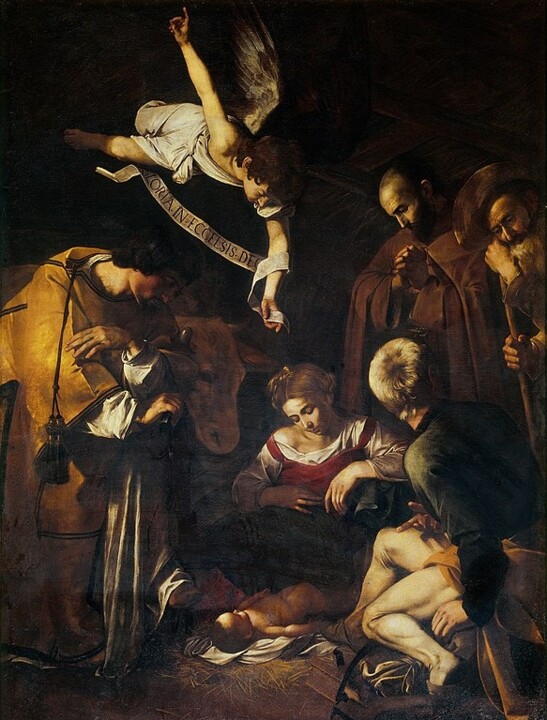 The Nativity with Saint Francis and Saint Lawrence, Caravaggio (1600) - 268x197 cm
The Nativity with Saint Francis and Saint Lawrence, Caravaggio (1600) - 268x197 cm
The composition of the work is characterized by the use of chiaroscuro, a technique that would become Caravaggio's trademark. This method creates a dramatic contrast between deep shadow and divine light, highlighting the main figures in the composition. The light seems to emanate from the Child Jesus himself, illuminating the faces of the figures around him and emphasizing the importance of his birth.
The arrangement of the figures creates a triangle, with the Child Jesus in the center, immediately drawing the viewer's eye to the main subject. The figures of Mary, Joseph, and Saints Francis and Lawrence are arranged around it in such a way as to guide the eye through the scene, creating a feeling of intimacy and contemplation.
Symbolism
- The Child Jesus : Source of light in the composition, he symbolizes hope and redemption for humanity. Its central position and the light which seems to emanate from it underline its divinity and its saving importance.
- Saint Francis and Saint Lawrence : Their presence links the nativity scene to themes of devotion and martyrdom. Saint Francis, known for his humility and love of poverty, reflects the humility of Christ's birth. Saint Lawrence, who was martyred, represents the ultimate sacrifice, an echo of the future passion of Christ.
- Mary and Joseph : Their humble and reverent depiction emphasizes the humanity of the scene, making the divine nativity accessible and emotionally poignant for the viewer.
Cultural Impact
Caravaggio's work had a profound impact on the art of his time and future generations. His chiaroscuro technique would influence many Baroque artists, and his ability to express deep emotions through realistic depictions would mark a turning point in art history. “The Nativity, with Saints Francis and Lawrence” is no exception, embodying a revolutionary approach to the religious scene that favors emotion and spiritual closeness.
This painting, beyond its artistic value, also played a role in Christian devotion and meditation. By presenting holy figures in intimate proximity to the holy family, Caravaggio invites the faithful to feel closer to the divine and human aspects of the nativity.
2. The Adoration of the Magi (around 1475) - Sandro Botticelli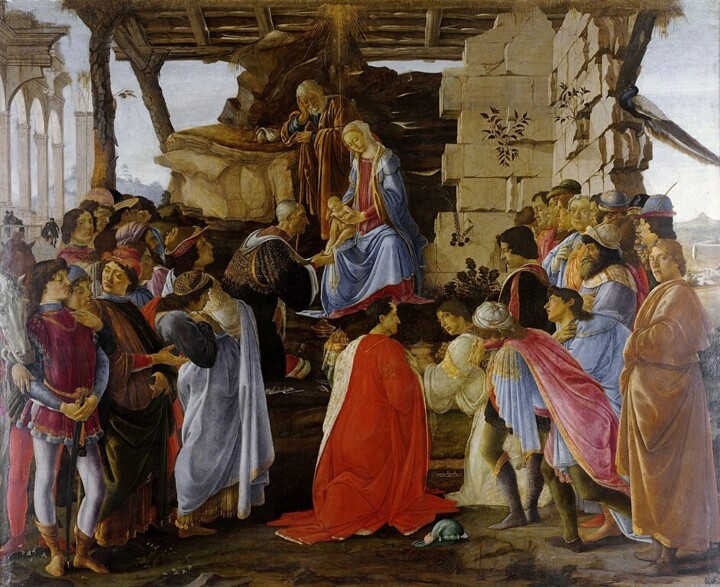 The Adoration of the Magi, Sandro Botticelli (1475), tempera on wood - 111 × 134 cm
The Adoration of the Magi, Sandro Botticelli (1475), tempera on wood - 111 × 134 cm
Composition
The composition of “The Adoration of the Magi” is organized around several main axes, with the Child Jesus, the Virgin Mary, and the Magi forming a central triangle that catches the eye. This structure creates a visual hierarchy that highlights the importance of the sacred scene. The figures are arranged in a semi-circle around the holy family, creating a space that feels both intimate and expansive.
The Magi, represented at different ages, symbolize the three ages of man and the universality of the adoration of Christ. Their gestures of adoration and offering direct attention to the Child Jesus. The presence of Botticelli's contemporary spectators, including prominent members of the Medici family, in the crowd around the main stage, establishes a link between the divine and the earthly, between the sacred past and the present of Renaissance Florence .
Symbolism - The Magi : Traditionally interpreted as representing the three parts of the known world at the time (Asia, Africa and Europe), the Magi symbolize the universality of the reception of Christ. Their worship means that salvation is offered to all humanity, regardless of race or social status.
- Medici Family : The inclusion of Cosimo de' Medici, his sons, and other members of the Medici family as figures among the Magi and spectators emphasizes the power and influence of the family, but also their piety and support for the arts and religion.
- Architecture and Landscape : The ruinous architectural setting may symbolize the old order of the world before the arrival of Christ, while the landscape in the background evokes both earthly reality and a larger spiritual horizon.
Cultural Impact
"The Adoration of the Magi" had a significant impact on Renaissance art and society for several reasons: - Patronage and Art : The work illustrates the crucial role of patronage in Renaissance art, showing how art served as both religious devotion and social affirmation for Florentine elites.
- Humanist Renaissance : By integrating contemporary figures into a biblical scene, Botticelli reflects the humanist spirit of the Renaissance, which valued the individual and observation of the real world while remaining deeply rooted in Christian spirituality.
- Artistic Legacy : This painting has influenced many generations of artists through its innovative composition and its integration of portraiture into religious storytelling, enriching the tradition of nativity art.
3. The Adoration of the Magi (1423) - Gentile da Fabriano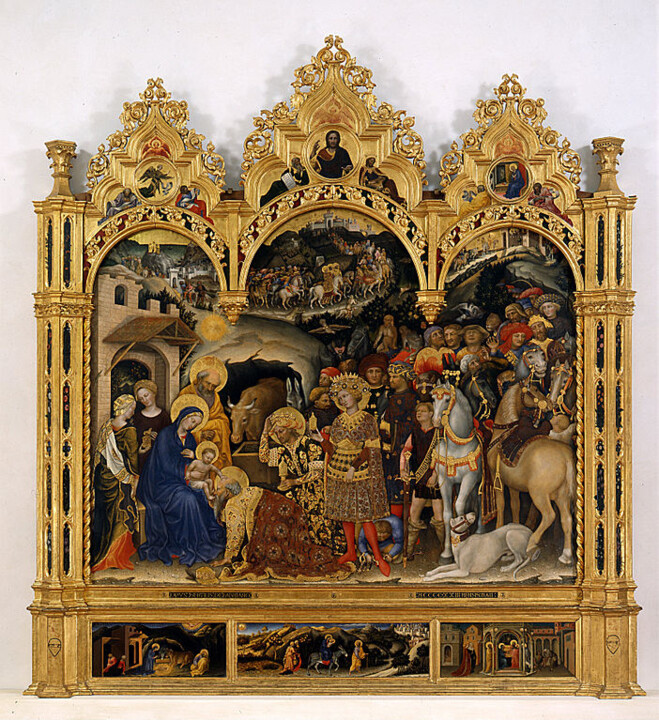 The Adoration of the Magi, Gentile da Fabriano, 1423 - 300x282 cm
The Adoration of the Magi, Gentile da Fabriano, 1423 - 300x282 cm
Composition
The composition of "The Adoration of the Magi" is remarkable for its richness of detail and its dynamism. The painting is divided into several scenes that tell not only the main story of the worship of the Magi but also the peripheral events, creating a rich and complex visual narrative. The central scene, where the Magi present their offerings to the Child Jesus, is surrounded by small groups of people and animals, all ornately dressed and detailed, a testament to Fabriano's skill at capturing splendor and complexity from the scene.
The use of gold and color adds a celestial dimension to the work, with lighting effects giving a sense of spatial depth and magnificence. The minute details of the clothing, armor, jewelry, and animals show a careful observation of nature and fashion of the time, while giving the work an almost magical quality.
Symbolism - The Magi : Depicted at different ages, the Magi symbolize the three ages of human life as well as the three known parts of the world at the time, emphasizing the universality of the Christian message.
- Gold and Offerings : The extensive use of gold in painting, as well as the precious gifts given by the wise men, symbolize the divine kingship of the Child Jesus and the recognition of his sovereignty over the world.
- Fauna and Flora : The detailed animals and plants are not mere ornaments; they often have a symbolic meaning, representing the entire creation coming to adore the newborn and announcing the renewal of life.
Cultural Impact
"The Adoration of the Magi" had a significant impact on the artistic development of the Renaissance. Her influence can be seen in the way she elevated pictorial storytelling to a new level of sophistication, combining religious devotion with detailed observation of the natural and human world. - Artistic Innovation : Fabriano introduced innovative techniques in composition and use of light, influencing generations of artists in Italy and beyond. His attention to detail and texture paved the way for a deeper exploration of reality and fantasy in art.
- Patronage and Society : The work also illustrates the importance of patronage in the arts of the Renaissance, reflecting the status and aspirations of the urban elites of the time, eager to link themselves to Christian themes while displaying their wealth and culture .
- Impact on the Renaissance : By integrating Gothic and Byzantine elements with innovations that foreshadowed the Renaissance, Fabriano's "Adoration of the Magi" marks a period of transition in European art, where the sacred and the profane, the celestial and the earthly, meet in a harmonious and imaginative way.
For further
To deepen your understanding and appreciation of religious Christmas art, here is a selection of references to visit exhibitions. These resources offer varied perspectives on the history, symbolism and cultural impact of artistic representations of Christmas throughout the centuries.
Exhibitions to Visit
- The Uffizi Gallery, Florence, Italy : Home to works by Botticelli and other Renaissance masters, this gallery is a must-see for admirers of religious Christmas art.
- The Rijksmuseum, Amsterdam, Netherlands : This museum has an impressive collection of works by Rembrandt, including his depictions of biblical scenes.
- The Prado Museum, Madrid, Spain : With a rich collection of religious art, the Prado offers insight into how Christmas has been interpreted by Spanish and Italian artists.
- The National Gallery, London, United Kingdom : This gallery has temporary and permanent exhibitions that often include works of religious art centered around Christmas.


 Jean Dubreil
Jean Dubreil